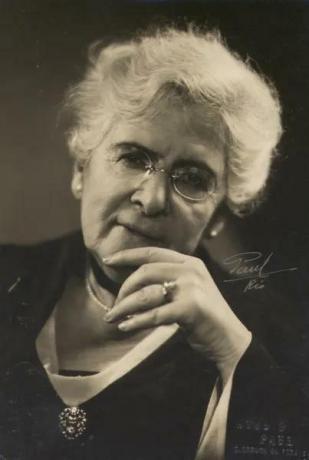O naturalism in Brazil was inaugurated in 1881, with the publication of the work the mulatto, by Aluísio Azevedo. The main feature of this period style is the determinism, that is, the fate of the characters is determined by race, the environment in which they live and the time in which they are inserted.
The characters in this type of novel also undergo zoomorphization, when the narrator attributes animalistic behavior to them. These two characteristics are quite evident in novels such as the tenement, by Aluísio Azevedo, and Bom-Crioulo, by Adolfo Caminha.
Read too:Romanticism — literary movement that marked the rise of individuality
Topics of this article
- 1 - Summary about naturalism in Brazil
- 2 - What are the characteristics of naturalism in Brazil?
- 3 - Main authors of naturalism in Brazil
- 4 - Works of naturalism in Brazil
- 5 - Historical context of naturalism in Brazil
- 6 - Solved exercises on naturalism in Brazil
Abstract about naturalism in Brazil
The romance the mulatto, by Aluísio Azevedo, inaugurated naturalism in Brazil in 1881.
The main feature of this period style is determinism.
In addition to Aluísio Azevedo, naturalists include writers such as Adolfo Caminha and Raul Pompeia.
the tenement, by Aluísio Azevedo, is the main Brazilian naturalist work.
What are the characteristics of naturalism in Brazil?
the mulatto, book by Aluísio Azevedo, was published in 1881. It is therefore the first romance Brazilian naturalist. However, it is the tenement, by the same author, which has the main characteristics of that period style, such as:
scientism: characters and their actions are constructed through an exaggeratedly scientific look.
Determinism: the fate of the characters is determined by their race, the environment in which they live and the time in which they are inserted.
Biologism: the biological aspects of the characters are more important than the psychological ones.
predominance of instinct: the instinct of the characters stands out over reason, especially the sexual instinct.
Zoomorphization: animalistic characteristics are associated with the characters, through comparisons or description of their behavior.
objective language: O storyteller seeks to portray reality without any sentimentality.
Antiromanticism: opposition to romantic idealization, as the naturalist text intends to show reality as it is.
Finally, we should mention that “naturalistic theories” are outdated, so that today some of them are nothing more than prejudices. We can cite, as an example, female hysteria, racial inferiority and “sexual inversion”. In this way, women, homosexuals and black people were despised in naturalist texts.
Do not stop now... There's more after the publicity ;)
Main authors of naturalism in Brazil
Aluísio Azevedo (1857-1913).
Adolfo Caminha (1867-1897).
Raul Pompeia (1863-1895).
Julia Lopes de Almeida (1862-1934).
Julio Ribeiro (1845-1890).

Works of naturalism in Brazil
the mulatto (1881), by Aluísio Azevedo.
The Athenaeum (1888), by Raul Pompeia.
The meat (1888), by Julio Ribeiro.
the tenement (1890), by Aluísio Azevedo.
Bom-Crioulo (1895), by Adolfo Caminha.
bankruptcy (1901), by Júlia Lopes de Almeida.
Read too:Symbolism — literary movement of the late 19th century
Historical context of naturalism in Brazil
When the British scientist Charles Darwin (1809-1882) published the book The origin of species, in 1859, the human being came to be seen as a result of a natural process of evolution, and no longer as a divine creation. And despite criticism from conservatives, this view has been accepted by much of the scientific community.
At the end of the 19th century, therefore, anthropocentrism prevailed, that is, the appreciation of reason. Thus, the positivist perspective was not limited to European lands and soon reached Brazilian territory. Here, he influenced intellectuals, writers and artists, in a troubled political context.
d. Pedro II (1825-1891) was the representative of a monarchy weakened, constantly attacked by the growing republican movement. Conservatism prevailed in Brazil, represented by slaveholding landowners, who resisted the abolitionists, who craved the end of slavery, only reached in 1888.
Solved exercises on naturalism in Brazil
question 1
(And either)
The Bom-Crioulo
In fact, Bom-Crioulo was not just a robust man, one of those privileged organizations that carry in their bodies the superior resistance of bronze and that they crush with the weight of their muscles. […] The lash did not hurt him; he had a back of iron to resist like a Hercules the wrist of the guardian Augustine. He couldn't even remember the number of times he had been beaten with a whip...
[…]
Meanwhile, it was already fifty lashes! No one had heard a moan from him, nor noticed a contortion, any gesture of pain. Only on that black shore could the marks of the reeds be seen, one over the other, crisscrossing like a great spider's web, purple and throbbing, cutting the skin in every direction.
[…]
Sailors and officers, in concentrated silence, lengthened their eyes, full of interest, at each stroke.
- One hundred and fifty!
Only then did anyone see a red dot, a red drop slide down the sailor's black spine and then this red dot turned into a ribbon of blood.
WAY, A.Bom-Crioulo. São Paulo: Martin Claret, 2006.
Naturalist prose incorporates concepts generated by scientism and determinism. In the fragment, the torture scene of Bom-Crioulo reproduces these conceptions, expressed by the
a) exaltation of innate resistance to legitimize the exploitation of an ethnic group.
b) defense of individual stoicism as a way of overcoming adversity.
c) conception of the human being as a predatory species and prone to morbidity.
d) detailed observation of the body to identify breed characteristics.
e) apology for the superiority of healthy organisms for the survival of the species.
Resolution:
Alternative A
The narrator seems to suggest that Bom-Crioulo's resistance is due to the fact that he is black. Hence the idea that people like this character were born to be exploited, as they would be able to withstand the harshest punishments.
Question 02
Analyze the excerpts from the novel the tenement, by Aluísio Azevedo, and mark the alternative in which it is NOT possible to identify a trait of animalization.
a) “They hated each other. Each felt a deep contempt for the other, which little by little was transformed into complete disgust. Zulmira's birth further aggravated the situation; the poor child, instead of serving as a link between the two unfortunates, was rather a new isolator that established itself between them. Estela loved her less than her mother's instincts demanded of her since she thought she was her husband's daughter, and he hated her because he was convinced that he was not her father.
b) “And the mournful mooing of that poor abandoned creature put a note before the rude agitation of the tenement. plaintive and sad of a cow calling in the distance, lost at nightfall in an unknown place and wild. But work was already heating up from one end of the inn to the other; she laughed, she sang, her tongue was loose; the anthill was busy with shopping for lunch; merchants were coming and going: the pasta machine was starting to snort. And Piety, sitting on the threshold of her door, patient and howling like a dog waiting for its owner, cursed the hour in which she left her land, and seemed prepared to die right there, [...].”
c) “The policemen, seeing that she did not hurry, drew their sabers. Bertoleza then, rising with the impetus of a wild tapir, leaped back and, before anyone could reach her, with a single, accurate and deep blow, he had ripped the belly from side to side. And then she sailed forward, roaring and thrashing, dying in a slush of blood.”
d) “The Albino, an effeminate, weak fellow, the color of boiled asparagus, closed the row of the first washerwomen and with a little brown hair, washed out and poor, that fell in a single line to her soft little neck and thin. He was a washerman and always lived among women, with whom he was already so familiar that they treated him as a person of the same sex; in his presence they spoke of things which they would not expound in the presence of another man; [...].”
e) “Miranda had never had her, nor had she ever seen her, so violent in pleasure. He found her strange. It seemed to him that he was in the arms of a passionate lover; she discovered in her the capricious charm with which courtesans trained in the science of venereal enjoyment intoxicate us. She discovered him in the smell of his skin and in the smell of his hair perfumes that she had never smelled from him; he noticed another breath, another sound in the groans and sighs. And he enjoyed her, enjoyed her madly, deliriously, with the true satisfaction of an animal in heat.”
Resolution:
Alternative D
It is possible to point out the following traits of animalization: “maternal instinct” (alternative A), “the anthill “Assanhava-se” (alternative B), “wild tapir impetus” (alternative C) and “satisfaction of an animal in heat” (alternative E). The excerpt from alternative D does not present animalization, but the prejudiced view that the character Albino, for being homosexual, is weak and unhealthy.
By Warley Souza
Literature Teacher
Read the analysis of the book “O cortiço”. Discover the main features of this work. Learn a little about the life of its author Aluísio Azevedo.
Meet the Brazilian writer Adolfo Caminha and find out what are the main characteristics of his works.
Find out who Aluísio Azevedo was. See his biography facts, understand his literary characteristics, and read a commentary on his major works.
Find out who Júlia Lopes de Almeida is and learn about her literary characteristics. See also what are his main works!
Read the analysis of the book “O Ateneu”. Know its plot, structure, characters and social critique. Also learn a little about the author's life.
Find out who Raul Pompeia was. Know your literary style and the characteristics of your works. Read a summary of “The Athenaeum”.


